Curator's Note
Throughout the world, women and girls are victims of countless and senseless acts of violence. The range of violence against women is devastating, occuring, quite literally, from womb to tomb. It occurs in every segment of society, regardless of class, ethnicity, culture, or whether the country is at peace or war.
This is the context for Off the Beaten Path: Violence, Women and Art (OTBP), and innovative, multi-media traveling contemporary art exhibition that utilizes works by world-class artists to promote awareness and behavioral choices; inspire the belief that communities can change a culture of violence; empower girls and women with respect to domestic violence, exploitation and discrimination; and address systems for social change. The beauty of this project is that it combines the highest integrity of art with important messaging and storytelling.
When we encounter violence against women, we often experience a sort of blindness. We choose not to see the devastation of domestic violence, calling it “a family affair.” Honor-killings of women in faraway regions of the world become nothing more than a “cultural difference.” We find it hard to believe that sex trafficking and exploitation occur in our cities, close to home. The rape and torture of women during armed conflict is the inevitable “messiness of war.” As such, the political and systemic sources of violence are underestimated or overlooked.
Premised on the visionary, poetic and prophetic potential in art, the stories that underlie these artworks by 32 artists from around the world return us imaginatively to the event of violation and allow it to affect us. Avoiding tabloid and sensational imagery, we ask the artists to help us create a new vocabulary - new representations - through their artworks, and in doing so, heal us, and transform us and help us feel and understand the essence of the problem of violence against women. And in the process we begin to forge a new journey - off the beaten path.
Randy Jayne Rosenberg, Curator
Oakland, California
Walking the exhibit...
Individual
It begins in the nucleus of an egg cell. Chromosomes meet. The Xs and Ys determine how cortical sex cords will form. For the first few weeks of fertilization, boys are no different than girls. Only in the ninth week does it become clear that the gonads will keep growing and become testes, or turn inward and develop under cover as ovaries. The female experience begins. Folding inward.
Some cultures honor the mysterious unseen qualities of womanhood, but it is far more common to give power to what is seen. The girl is often expected to remain hidden, smaller, silent. Or decorative, available, and sweet. There are women who rebel and raise their voices, fight. Their battles are waged in the seemingly safe lawns of suburbia, bright classrooms, shopping malls. Battle scars appear in these seemingly benign environments. The fragile ribs of an anorexic. The deformed foot stepping out of a stiletto. The false laughter ringing through the halls of a high school.
Jung Jungyeob, Korea
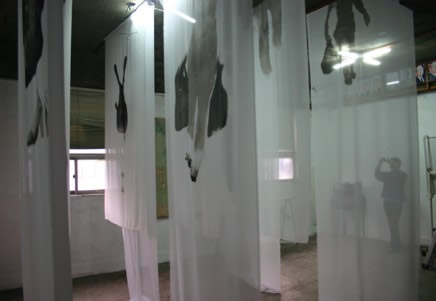
Korea Being #1-15, 2007 India ink on synthetic chiffon
Female silhouettes emerge through ink washes on sheer silk. The figures are in continuous motion, yet suspended, apparently engaged in the daily rituals of women everywhere -carrying grocery bags, walking, looking after children, and cooking. They are fading and approaching invisibility, suggesting a state of anonymity and insignificance.
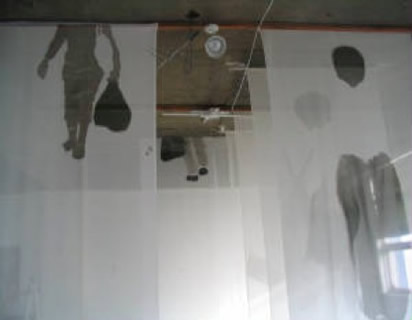
Korea Being #1-15, 2007 India ink on synthetic chiffon
Female silhouettes emerge through ink washes on sheer silk. The figures are in continuous motion, yet suspended, apparently engaged in the daily rituals of women everywhere -carrying grocery bags, walking, looking after children, and cooking. They are fading and approaching invisibility, suggesting a state of anonymity and insignificance.
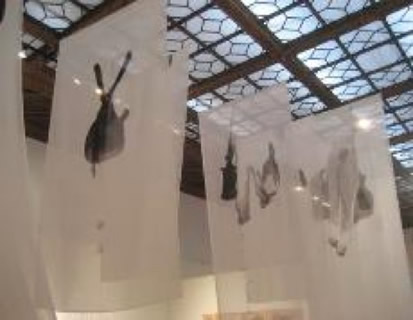
Jung Jungyeob, Korea Being #1-15, 2007 India ink on synthetic chiffon
Female silhouettes emerge through ink washes on sheer silk. The figures are in continuous motion, yet suspended, apparently engaged in the daily rituals of women everywhere -carrying grocery bags, walking, looking after children, and cooking. They are fading and approaching invisibility, suggesting a state of anonymity and insignificance.
Lise Bjorne Linnert, Norway
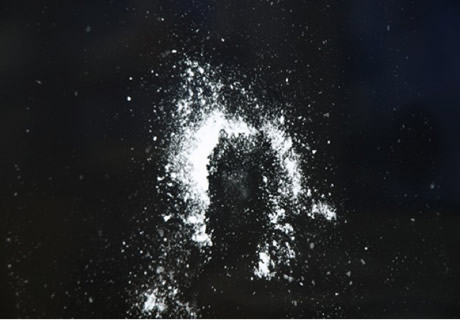
Breath Series, 2008, 4 Rayographs, Approx 70 x 40 inches each
Inspired by Man Ray's rayographs, Lise Bjorne created the Breath Series in a darkroom without use of a camera. As she breathes, screams, and yells, a trace of her out-breath is captured by the light sensitive paper. The movement of her knees, hands and mouth leave empty, dark areas on the image. These shadows are all that remain of her outburst--no matter how violent. She remains hushed and invisible.
Miri Nishri, Israel
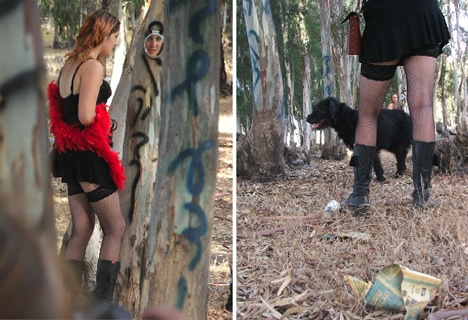
Esther-Queen of the Swamp, Video projection, 2009
On the outskirts of Tel Aviv, in a swampy dumping ground adjacent to a highway, lays a forgotten forest dedicated to the biblical Esther. It was here that she is said to have hid from those who loved her and those who wanted her dead. A man comes here, unseen, and leaves poems in the trees. In her video, Miri Nishri has given him a voice, disembodied, haunting. He recites not love poems but poems of an obsessive. Aggressive, frighteningly blunt. The trees call out to Esther, whose persona is split into two-a young prostitute and an old homeless woman. The two alternately merge and wander apart as they await their fate. The anonymous hunter/poet shadows them. The viewer is put in his shoes, stalking them.
Miwa Yanagi, Japan
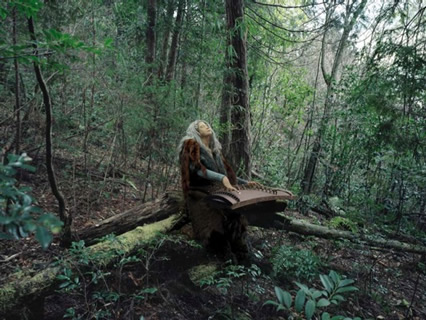
Tsumugi, Estelle, Kwanyi, from the Grandmother Series 3 photographs
Miwa Yanagi explores issues of feminine self-image and aging in a series of interviews and staged photographs of young Japanese women that she met over the Internet. She asked her subjects to project their futures: How does a modern girl forecast life fifty years from now? Yanagi found that rather than dreading the indignities of aging, the women believed they will enjoy power, respect, and adventure. They flipped Japanese tradition, refusing to conform to the role of the crone, or that of the perpetual girl. Using makeup, costumes, and digital manipulation, Yanagi transformed the young women into their future selves. The resulting images are of strong old ladies who freely express themselves.

Tsumugi, Estelle, Kwanyi, from the Grandmother Series 3 photographs
Miwa Yanagi explores issues of feminine self-image and aging in a series of interviews and staged photographs of young Japanese women that she met over the Internet. She asked her subjects to project their futures: How does a modern girl forecast life fifty years from now? Yanagi found that rather than dreading the indignities of aging, the women believed they will enjoy power, respect, and adventure. They flipped Japanese tradition, refusing to conform to the role of the crone, or that of the perpetual girl. Using makeup, costumes, and digital manipulation, Yanagi transformed the young women into their future selves. The resulting images are of strong old ladies who freely express themselves.
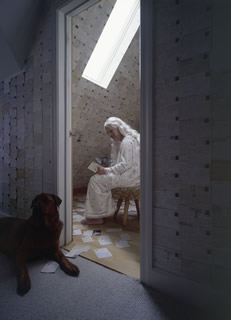
Tsumugi, Estelle, Kwanyi, from the Grandmother Series 3 photographs
Miwa Yanagi explores issues of feminine self-image and aging in a series of interviews and staged photographs of young Japanese women that she met over the Internet. She asked her subjects to project their futures: How does a modern girl forecast life fifty years from now? Yanagi found that rather than dreading the indignities of aging, the women believed they will enjoy power, respect, and adventure. They flipped Japanese tradition, refusing to conform to the role of the crone, or that of the perpetual girl. Using makeup, costumes, and digital manipulation, Yanagi transformed the young women into their future selves. The resulting images are of strong old ladies who freely express themselves.
Walking the exhibit...
Family
Every family begins within the body of a woman. She is the miracle maker. Her body provides the first dwelling, the first repast, the first contact. But instead of being honored as a temple, she is more often treated as a slave. Or worse. Women become victims of violence in their own homes more than any other environment. The most powerful adversary is often the one who knows his victim most intimately. In many cultures, if a woman is perceived as violating her role, if she attempts to assume power or have the audacity to make decisions about her body, violence is an accepted response. There are times when a woman must break the branches of her family trees, leave the shadowy shelter, and find her own "family" in the world.
Laylah Ali, USA
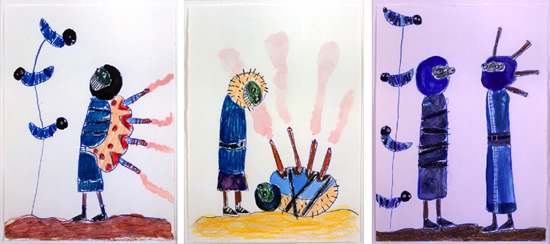
Unitled, 2004 Colored pencil and graphite on paper, 7.5 x 10 inches
Untitled, 2002 Ink on paper, 16.5 x 11.75 inches
Untitled, 2002 Ink on paper, 16.5 x 11.75 inches
Laylah Ali's paintings resemble comic-book serials, but they also contain stylistic references to hieroglyphics and American folk-art traditions. Ali achieves a stark emotional tension in her work by pairing brightly colored scenes with dark, often violent subject matter that speaks of political resistance, social relationships, and betrayal. A never-ending cycle of violence, anger and anxiety is illustrated alongside a sense of female solidarity. Ali is able to conflate the wider societal issues of violence with the more pointed maternal issues of responsibility and obligation.
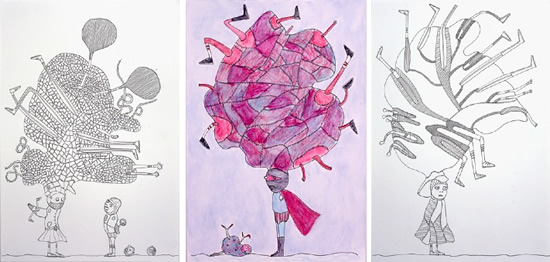
Untitled, 2002 Ink on paper, 16.5 x 11.75 inches
Untitled, 2002 Ink and watercolor pencil on paper, 11.75 x 8.25 inches
Untitled, 2002 Ink on paper, 16.5 x 11.75 inches
Laylah Ali's paintings resemble comic-book serials, but they also contain stylistic references to hieroglyphics and American folk-art traditions. Ali achieves a stark emotional tension in her work by pairing brightly colored scenes with dark, often violent subject matter that speaks of political resistance, social relationships, and betrayal. A never-ending cycle of violence, anger and anxiety is illustrated alongside a sense of female solidarity. Ali is able to conflate the wider societal issues of violence with the more pointed maternal issues of responsibility and obligation.
Yoko Ono, Japan
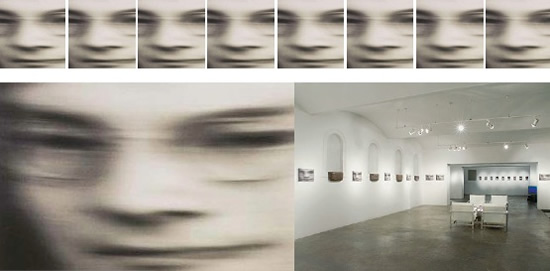
Vertical Memory series, 1997, 21 Iris prints with individual texts, 12.2 x 19.3 inches each
"Vertical Memory was created putting together photographs of my father, my husband and my son," says Ono. "I selected photographs of them facing the same direction, overlapped them and morphed them into one composite image. Every photo represents the man who was looking over me in a precise moment when I went through an important situation of my life."
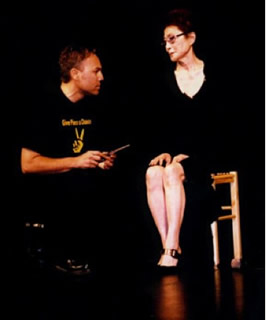
Cut Piece video, 1965, + 2003, 2 monitors
In Cut Piece, Yoko Ono sits onstage in a black dress with her body becoming increasingly exposed as people cut away pieces of the dress. Like vultures taking a piece of her, the audience violates Ono's body, shredding her clothes, stripping almost naked. But throughout most of the performance, she sits motionless, trying to maintain a composed stare toward the audience.
Jaune Quick-to-See
Smith, USA
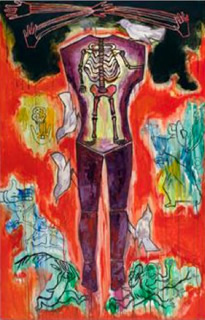
The Child Within, Oil painting, 6 x 4 feet
Jaune Quick-to-See Smith employs color to signal rage, despair, and possible change. The color red back-grounding white birds, a rabbit chasing a farmer, an outstretched hand, and a headless, armless figure, suggests rage and conflict amid fleeting peace and tortured domesticity. Inky black spreads at the top of the painting, where a head is missing, indicate encroaching despair, doom, and a lack of leadership. A child's skeleton rests in the ribcage of the larger figure and it too is headless. The missing arms suggest a lack of power, the missing head, a lack of identity but the white birds walking on the figure suggest that peace, while difficult to corner, is present.
Gabriela Morawetz, Poland
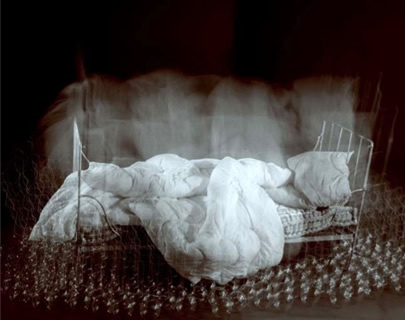
The Sleeping Self, 2009 Photographic transfer, emulsion and wax on canvas, 180cm large x 110cm high
The bed is supposed to be a place of dreams, a comfort zone where one goes to rest the body and mind. But for some, it is a place where the body is violated, trust destroyed. The beds in Morawetz's Sleeping Self series have accumulated mysterious objects, transforming them. A mattress is piled high with bubbles or fragile glass balls. A figure is entombed in filiments of light, or are they brightly lit nails? As in a dream, these images are removed from any particular time and place. Sometimes the figure is missing altogether, leaving the viewer wondering what has happened to the vulnerable sleeper.
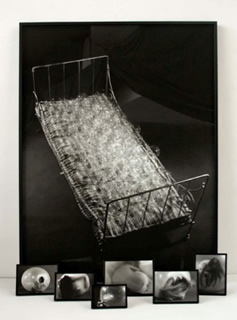
The Sleeping Self, 2009 Photographic transfer, emulsion and wax on canvas, 180cm large x 110cm high
The bed is supposed to be a place of dreams, a comfort zone where one goes to rest the body and mind. But for some, it is a place where the body is violated, trust destroyed. The beds in Morawetz's Sleeping Self series have accumulated mysterious objects, transforming them. A mattress is piled high with bubbles or fragile glass balls. A figure is entombed in filiments of light, or are they brightly lit nails? As in a dream, these images are removed from any particular time and place. Sometimes the figure is missing altogether, leaving the viewer wondering what has happened to the vulnerable sleeper.
Louise Bourgeois, France
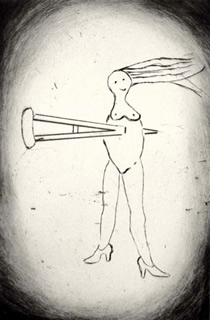
THE ACCIDENT, 1999, Drypoint on paper 17 x 15"
Louise Bourgeois's drawings and sculptures often explore themes of intimate relationships, home, familial hierarchy, motherhood, and sexuality with rebellious originality. In this piece, a female figure is alone in a black tunnel. Her torso is skewered by a crutch, she is cobbled by her high heels, nude, armless, yet she smiles complacently. Like a woman trapped in a violent family situation, she wears a mask that tells the world everything is just fine.
Patricia Evans, USA
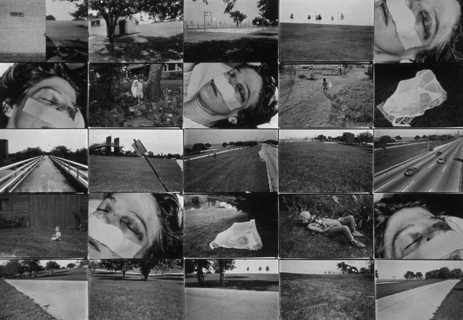
Late 1990's installation of twenty five 11"x 14" B & W photos total size 5'x 6'3"
The title is the last line of the book, "Working With Available Light," by Jamie Kalven, Patricia Evans' husband. His writing describes the effect of Patricia's rape on the family and community. In 1988, Evans was sexually assaulted and severely beaten while running on Chicago's lakefront in mid-afternoon. The photography is a landscape of the artist's assault.
Walking the exhibit...
Community
Community of sisterhood is powerful. Whether it be an artist collective, a political group, a book club, or a girl's school, the gathering of women in solidarity leads to the development of their voices, their skills and knowledge. Unfettered by expectations of submissiveness, surrounded by true peers, a woman can say what she needs, share what she knows, ask for credit where it is due, learn her rights. The billboards and television shows and magazines may all tell her she should look and act a certain way. Be pleasing and quiescent. But a true community can tell her otherwise. She rises above the noise and discovers her presence, her gravity, her wisdom. With these tools she begins to integrate into the larger community, skillfully, and with confidence.
Yoko Inoue, Japan
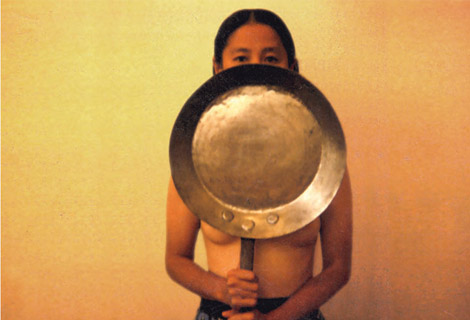
"Untitled", photograph of a performance, 36" x 36"
In some communities, where direct intervention is culturally impossible, women respond to severe domestic violence by assembling outside of the household in question and bang out an alarm on pots and pans. This informs the man that the spirit he attempts to break belongs to many, not one.
Luciana Fina, Portugal/Italia
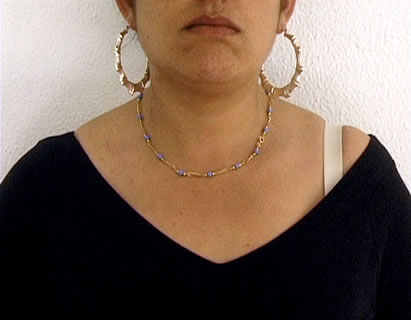
HORS SUJET, Video Portrait, 2009
Fina conducted a workshop with "working girls" of Lisbon. In discussion, their desire was not to tell stories about prostitution or affirm or defend their choice of work. In fact, what she discovered of primary concern was their lack of comfort in their own body image because of social stigma. The work resulted in an exploration that went beyond the face-to-face encounter and representation of the portrait by the artist. Over time, Fina began to look at the relationship between the model, the artist and public within the larger context of art history.
Icelandic Love Corporation, Iceland
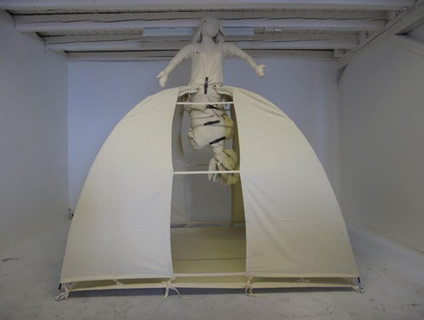
Sigrun Hrolfsdottir, Joni Jonsdottir, Eirun Sigurdardottir, Woman, 2009
In our lives women are strong and role models are all around. Mothers, daughters, witches, healers, artists, presidents, pioneers.
History shows that we can be leaders on the road to equality.
It is as if we have been given a different starting point than most of our sisters. This is an advantage and a luxury.
But still there is inequality and still there is discrimination and violence.
Societies create systems and a system is security but systems can also be traps.
Now that one system has failed can we use the opportunity to renegotiate?
The piece "Woman" shows two faces of reality. In one person. In one world.
Will there ever be one reality?
Walking the exhibit...
Culture
What is tradition? When should it be rejected? Certain acts or practices may be repeated throughout the centuries, but that does not necessarily mean they should be honored and protected. Yet we live in a world in which harmful, sometimes violent, cultural practices are accepted despite the fact that they can lead to physical and psychological harm to women. The practices of female genital mutilation, dowry murder, "honor killings,- early marriage, and other ritualized human rights violations persist.
It takes individual courage to challenge deeply imbedded belief systems. It takes collective outrage to create change within a culture. But if we are to see the pandemic of violence against women subside, outrage must be channeled into peaceful action. New traditions, ones that empower rather than subjugate, have the potential to emerge but only if we plant seeds of understanding and compassion are planted.
Hung Liu, China
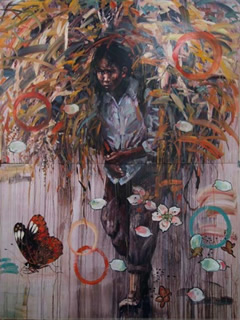
Demeter, 2008, 8 x 5 feet, oil on board
Hung Liu is interested in chronicling the lives of oppressed people who have been otherwise forgotten. In particular, she is interested in the stories of women and children who are often erased from social history. It's something she experienced first-hand. During the Cultural Revolution, Liu's family photographs were confiscated as part of a campaign to encourage less individual identity. Much of the imagery in her painting is based on 19th and 20th century photographs taken by Western visitors to China. In Demeter we see a young woman captured under the heft of a huge load, yet Liu has imbued the image with levity, beauty and hope. She has rewritten the woman's history. "The artwork is my way of painting life back into memories," she says.
Hank Willis Thomas, USA
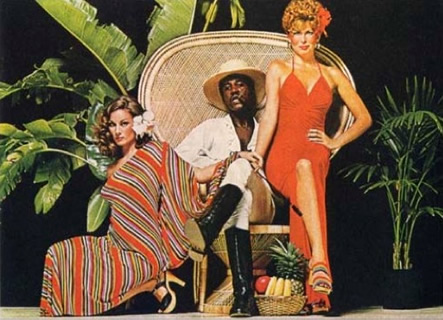
Are you the Right Kind of Women for It?, Unbranded Series, 1974/2007 Digital C Print
For the Unbranded series, Thomas took magazine advertisements directly targeting a black audience, and published since 1974. Thomas digitally manipulated and appropriated the images, removing any signature of the client -text, logos, slogans. He left the images unaltered and in doing so he revealed what is actually being "sold". In this piece, we see a powerful black man flanked by two white women. He is seated like a king, his expression tough, a cigar jutting upward from his open mouth. A fruit basket sits at his feet. The women each drape a hand over his knee. What is not being said? Sometimes the unspoken is deafening.
Myung-Jin Kim, South Korea
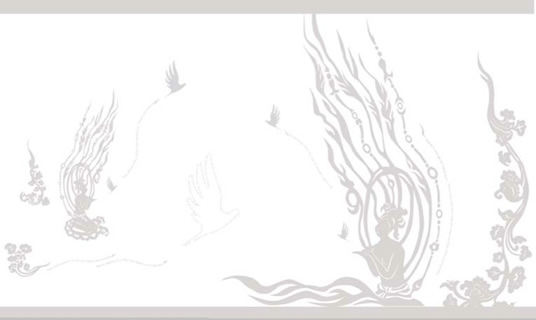
Invisible inVisible, 2008 9 x 25 feet, 3M Adhesive sheet
The image in Myung-Jin Kim's Invisible inVisible borrows from an 8th century bronze temple bell in Korea. While the artist usually works in color, her choice of white on white reflects the subtle ways in which women are erased as their voices and identities are devalued and minimized in Confucian tradition. Starting in the late 14th century, Korean culture began stripping rights away from women by imposing limits on their freedom of movement, inheritance, marriage, and ancestral rituals. By 1800, as if they were invisible ghosts, daughters weren't even entered in family registers.
Lucy + Jorge Orta, UK and Argentina
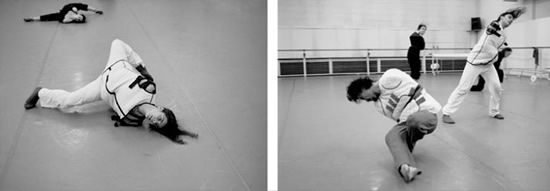
Borderline - Couvertures de Contention, Cotton, various fabrics, clips and webbing, 2002
Orta's detournment of the straitjacket attests to the imposed limitations on female achievement and realization while suggesting the added insult that women are mentally unstable. The contemporary dance performance - Borderline - displays the artfulness, adaptability, and grace women have honed over time even within society's constraints. In Ortas work, awkward positions have been turned into sculpture and new forms continue to emerge.
Marina Abramovic, Serbia
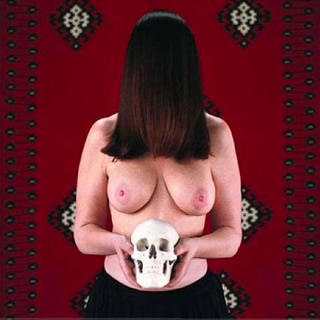
Balkan Erotic Epic:Banging the Skull, Video
Marina Abramovic is concerned with the idea of unity between body and soul. Through the video series, Balkan Erotic Epic, she examines our physical existence imbued with a new consciousness. The work is based on Abramovic's research into the Balkan folk culture. Through eroticism and the sexual act, the human attempts to be equal with the gods: the woman marries the sun and the man marries the moon. Through the impetus of becoming at one with the heavens, the individual tries to preserve the secret of fertility, creative energy and the strength of the cosmic forces. According to this folklore, the individuals believed that through the fusion with the gods, they take on superhuman qualities.
Almagul Menlibayeva, Kazakhstan
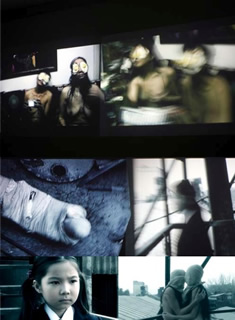
Kissing Totems, Video installation, 2-channel mini DV, 9 minutes
Menlibayeva conceives mythological narratives based upon cultural legacy, shamanistic practices and the nomadic heritage in the Steppes of her native Kazakhstan. She uses the industrial ruins of the region's communist past during the Soviet era, scripting her characters into a complex visual tale. The mutable quality of female identity and the dueling forces of tradition and emancipation are fundamental to Menlibayeva's work. The women in her videos are not held to culture-specific or gender-based expectations and are, therefore, free. Menlibayeva suggests that one day these subversive women will be the bearers of new values.
Maimuna Galgano, Pakistan
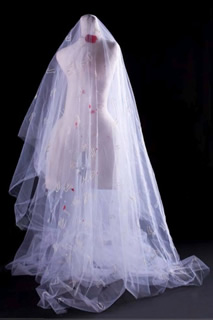
N0, 2007, 178cm, wool, cotton, plastic glass, metal
Bride-burning is a form of domestic violence practiced in Pakistan and other countries located on or around the Indian subcontinent. Bride-burning occurs when a young woman is murdered by her husband or his family for her family's refusal to pay additional dowry. The wife is typically doused with kerosene, gasoline, or other flammable liquid, and set alight, burning to death. In some cases, the attack is disguised as an accident or as suicide. According to an Amnesty International report in 1999, though 1,600 "bride-burnings" were reported, only 60 were prosecuted and just two resulted in convictions.
Masami Teraoka, Japan
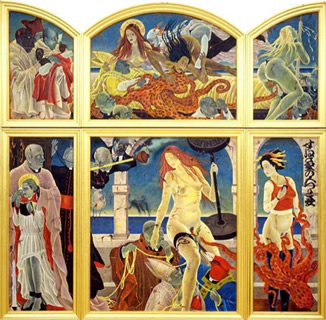
Series of 10 small paintings Wall installation Approx 4 x 5 feet
Masami Teraoka challenges viewers by visually weaving news media, reality, and fantasy, with humor, traditional form, and vivid color. The result is a highly aesthetic topical commentary that contains a barrage of references ranging from historical to immediate. He illustrates the duality of human nature with a combination of sacred tropes and modern sin; the staff carried by a priest in a religious procession is also the stripper's pole. Since the late 1990s, he has been producing figurative paintings addressing social and political issues, especially the abuse of children, women and nuns by priests. These paintings borrow from well-known Renaissance paintings.
Cecilia Paredes, Peru
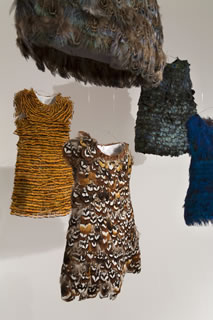
The Flight, 2008, Photograph, approx 60 x 65 cms each
In The Flight, the artist presents a series of seven small floating dresses crafted from feathers, coral, boar's teeth, and other exotic materials. Her combination of contemporary fashion and traditional materials is a fashion statement that recalls the Andean re-signification that caused friction in the Roman Catholic church in the 16th century. When evangelists introduced Roman Catholicism to Peru, the natives took the religious accouterments and incorporated their own traditions. Feathers typically used in their own clothing were sewn into the Catholic robes. This hybridism was viewed by the Spanish priests as dangerous rebellion and was ferociously prohibited. Paredes intertwines this concept into her work with the feminist ideal of freedom and identity. She re-interprets the image and meaning of the feather.
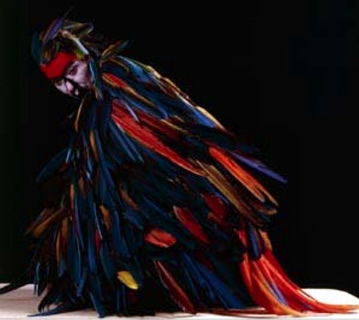
The Flight, 2008, Photograph, approx 60 x 65 cms each
In The Flight, the artist presents a series of seven small floating dresses crafted from feathers, coral, boar's teeth, and other exotic materials. Her combination of contemporary fashion and traditional materials is a fashion statement that recalls the Andean re-signification that caused friction in the Roman Catholic church in the 16th century. When evangelists introduced Roman Catholicism to Peru, the natives took the religious accouterments and incorporated their own traditions. Feathers typically used in their own clothing were sewn into the Catholic robes. This hybridism was viewed by the Spanish priests as dangerous rebellion and was ferociously prohibited. Paredes intertwines this concept into her work with the feminist ideal of freedom and identity. She re-interprets the image and meaning of the feather.
Lise Bjorne Linnert, Norway
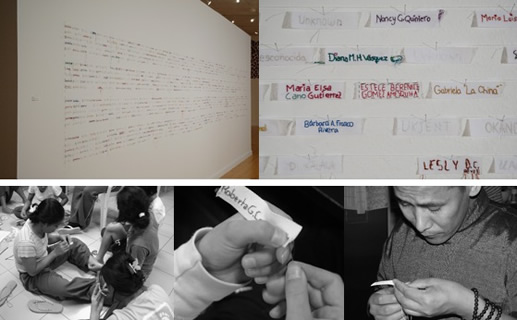
Desconocida, Wall installation of embroidered labels
Eleven hundred people from 23 countries have participated in Desconocida,the Spanish word meaning "unknown," by embroidering nametags of missing loved ones from Juarez, Mexico. The names, attached to the wall, are arranged in morse code to spell out the Mexican Anthem. The project, a call for help, addresses the critical situation in Juarez, a city on the border of Mexico and the United States, where women have been found raped, tortured, and killed since 1993. Hundreds more continue to disappear, most murders remain unsolved with no end in sight. Desconocida is a community-based project to fight against abuse, femicide and human trafficking.
Maria Magdalena Campos-Pons, Cuba
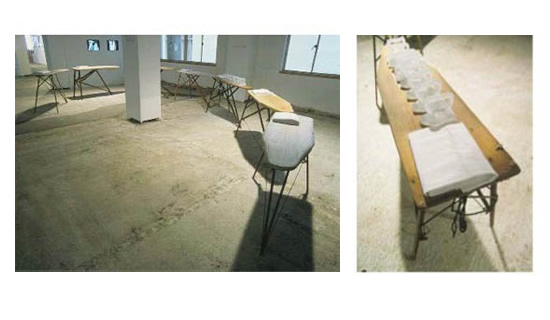
Unfolding Desires, 1997/1999 Installation, Ironing boards, sheets, cast glass irons, video
Maria Magdalena Campos-Pons has made the journey from Cuba to America, continuing the displacement begun when her Yoruba ancestors were shipped from Nigeria as slaves. Her work traces the histories of people for whom the past is not as distant as we might like to think. Campos-Pons' grandfather was transported to Cuba and forced to work on the Vega sugar plantation, and her family was still living and working on the plantation when she was growing up.
Amnesty Sweden Campaign
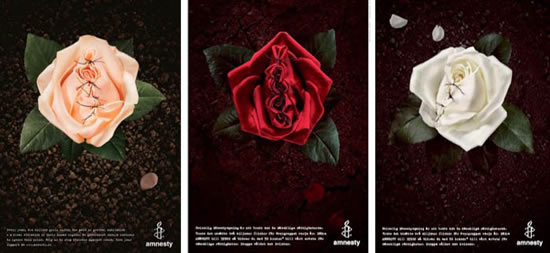
Rose Petals
Credit: Agency: Volontaire
Creatives: Malin Triumf, Yasin Lekorchi
Photo: Niklas Alm/Vostro
Retouch: Sofia Cederstrom/Vostro
Walking the exhibit...
Politics
What is tradition? When should it be rejected? Certain acts or practices may be repeated throughout the centuries, but that does not necessarily mean they should be honored and protected. Yet we live in a world in which harmful, sometimes violent, cultural practices are accepted despite the fact that they can lead to physical and psychological harm to women. The practices of female genital mutilation, dowry murder, "honor killings,- early marriage, and other ritualized human rights violations persist.
It takes individual courage to challenge deeply imbedded belief systems. It takes collective outrage to create change within a culture. But if we are to see the pandemic of violence against women subside, outrage must be channeled into peaceful action. New traditions, ones that empower rather than subjugate, have the potential to emerge but only if we plant seeds of understanding and compassion are planted.
Mona Hatoum, Palestine
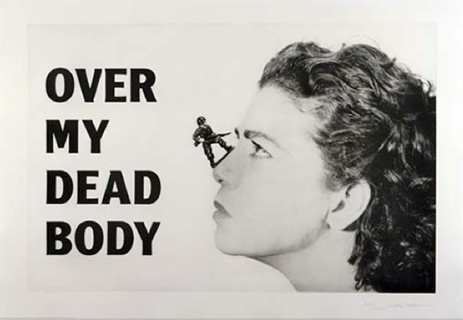
Palestine Over My Dead Body, 2006 Heliogravure, 27.5 x 39.5 inches
Over My Dead Body, is a call to action for women to stand up against violence in every form - from domestic to warfare. By placing a tiny toy soldier on the nose of a determined woman, Hatoum has made violence appear small in the face of female solidarity and resolve having the viewer believe that women as a whole have the power to stop violence. Yet the title invites the viewer to consider what sacrifices must be made to achieve this goal.
Susan Plum, Mexico
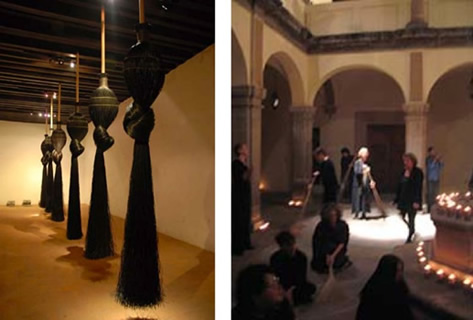
Luz y Solidaridad, 2006, Installation of brooms, video of performance
Brooms evoke many connotations-- from the mystical to the mundane. For Plum, they reference the sacred act of sweeping the temples in Pre-Hispanic Mexico, an act that was performed during ritual cleansing and was also thought to elicit the earth's healing spirit. Plum created these over-sized brooms to invoke healing for the senseless death and disappearance of women and girls from Juarez, a Mexican border town across from El Paso. The scale of the objects conjures the enormity of the loss.
In the video performance, 25 women use the sounds and movement of brooms, wind whistles, bullroarers, and spinners as a limpia---a shamanic cleansing for the murdered daughters and a gift of empowerment to the mothers of the missing.
Wangechi Mutu, Kenya
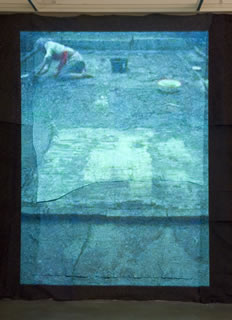
Cleaning Earth, 2006 DVD Video
Courtesy of Sikkema Jenkins & Co
Wangechi Mutu's video, Cleaning Earth documents a twenty-five minute performance wherein the artist systematically scrubs a filthy concrete slab. Clad in a skirt, blouse, apron and kerchief, Mutu gets on her hands and knees, throwing her back into the job. Her repetitive sweeping circular motions, the grainy footage that obscures detail, and the video's unedited, single take all make for tedious watching. As we endure, five, ten, fifteen minutes, the women gets more mud on herself than off the floor, she begins to tire, and eventually flops lethargically into the mud. We don t just see the futility of her task--we feel it too.
Amal Kenawy, Egypt
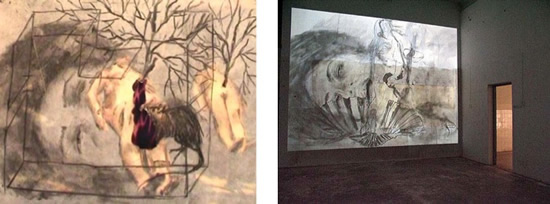
You Will Be Killed, 2006, Video Animation installation
The video installation "You Will Be Killed" was first presented in a former military hospital, a location that functioned as the nexus for destruction and repair, wrath and compassion. This was where the unthinkable was addressed as limbs were re-attached or lost and lives were saved or not. Amal Kenawy projects her own image on the walls throughout the building as a way of combating, tempering, and understanding the violence of war.
Eve Sussman and the Rufus Corporation, USA
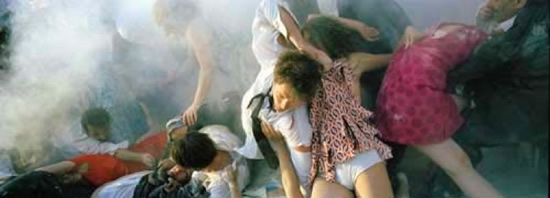
Rape of the Sabine Women, 80 minute video installation
Eve Sussman's Rape of the Sabine Women is a modern rendition of Jacques-Louis David's 1799 painting of the same name. Both works are based on a Roman myth in which the raped and captured women intervene on the battlefield to stop the war. On the field the women and children surged en masse and came between the two armies. In this ecstatic gesture, the women forced the unification of these two cultures and resulted in the expansion of Rome. In the video, Sussman recasts the two sides of the myth in a 1960's context: Romans become G-men and the Sabines are butchers' daughters.
Jane Alexander, South Africa
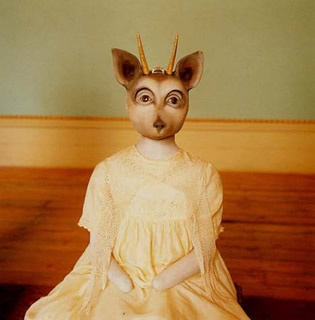
Newly commissioned artwork--not image shown
Jane Alexander bestializes the human form in her work, creating a human/animal mutant that challenges the notion of civilization by imposing upon it the laws of the animal kingdom. By conjuring animal nature, Alexander elucidates the cycle of violence that is a natural part of survival for animals. By putting it in a suit or a dress she questions why violence exists in civilized society where it isn't necessary for survival.
Joyce J. Scott, USA
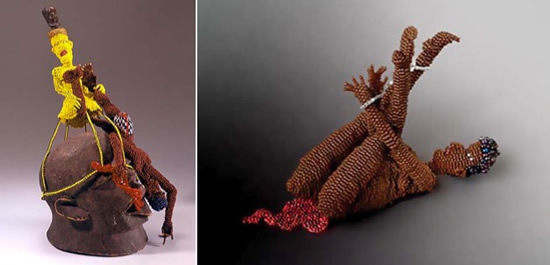
Day After Rape, 2008 Darfur I, 2008
Seedbeads and thread, Each approximately 6x6x6 inches
Almost all of the female refugees who survived the Darfur genocide report being raped at least once. Some victims are as young as four years old. Researchers concluded that in Sierra Leone, 50,000 to 64,000 internally displaced women may have been sexually victimized during its protracted armed conflict. Up to 95% of a refugee camp's population can be unarmed and defenseless women and children
A Global Crescendo: Women's Voices from Conflict Zones
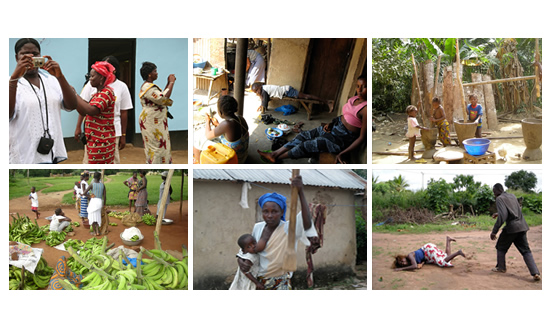
Voices from the Field/International Rescue Committee, A Global Crescendo: Women's Voices from Conflict Zones, 2008 Photography Installation
Driven by Ann Jones an accomplished writer, and photographer the International Rescue Committee (IRC) embarked on a project in 2007 to show the world how women live in conflict zones. Who better to describe the circumstance than the women themselves using photography, eliminates all language barriers? Women living in areas of conflict are frequently portrayed as helpless and voiceless. We see them in news photos and they appear mute: working, holding children, hauling water and firewood, or just staring into the lens. The IRC has asked them to document their lives and the results are profound. They are anything but mute. We hear their voices, see their strength, and witness their pride.
Click the right arrow to see all 20 pictures
Thank You for Watching!
Continue scrolling to see how you can help
Take Action
Stay informed. Find out more about what is going on from various news sources and organizations. www.unifem.org/news_events/
Support relief efforts. Donate to the International Rescue Committee www.theirc.org/
Contact the Media. Write a letter to the editor of your local or national newspaper to comment on their coverage of women in war and violence against women. Express how important it is for women and girls in conflict to receive public attention via the media. Amnesty International USA www.amnestyusa.org
Join the cause - sign up to the United Nations "Just say NO to Violence Against Women and Girls" Make your voice be heard UNIFEM www.unifem.org
Communicate with your Government. Send a letter to your President, your Parliamentarians, your government representatives that enough is enough -that the dollars they are spending overseas must prioritize women and children's needs, education, work life and health.
Make Some Noise, Join musicians and artists in a collaborative effort to support human rights. www.artforamnesty.org
Experience the stories of survivors of sexual violence and offer a sense of solidarity to those who have lived through rape and abuse while raising awareness. Voices and Faces Project www.voicesandfaces.org
Become part of a global women's movement that is rooted in a commitment to justice and appreciation of the value of women's experience and basic human rights. Global Fund for Women www.globalfundforwomen.org
Be a role model. Teach both girls and boys that there is no place for violence in a relationship. Family Violence Prevention Fund www.endabuse.org
Speak up and find your voice. Whether it is through writing your government, a song, or a letter to your newspaper, stand up for what you believe. Amnesty USA, Stop Violence Against Women Campaign www.amnestyusa.org Rock' N' Roll Camp for Girls www.girlsrockcamp.org
Celebrate International Women's Day UNESCO www.unesco.org